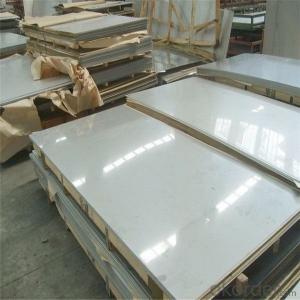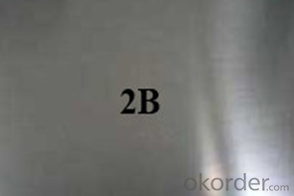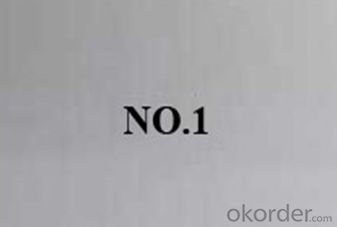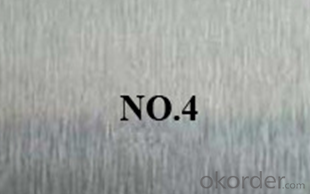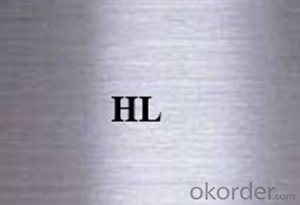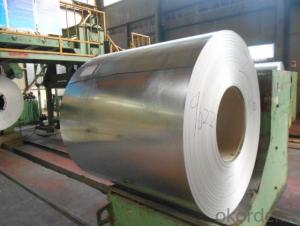321 Stainless Steel Sheet perfect price strong hardness
- Loading Port:
- Shanghai
- Payment Terms:
- TT OR LC
- Min Order Qty:
- 1 m.t.
- Supply Capability:
- 20000 m.t./month
OKorder Service Pledge
OKorder Financial Service
You Might Also Like
Item specifice
perfect price strong hardness 321 stainless steel sheet
Product Description
specification information of stainless steel sheet 321
| Type | stainless steel sheet 321 |
| Thickness | 0.4-6mm |
| Width | 1000mm,1219mm,1250mm |
| Length | 1000-6000mm or as customers' request |
| Standard | AISI,ASTM,EN,BS,DIN,JIS,etc |
| Material | 321 |
| Surface | 2B,BA,No.4,BH,BA,polishing 8K |
| Brand name | TISCO,ZPSS,LISCO |
| Packaging Standard | export sea-worthy package,covered with PVC,and wooden case,or customize package |
| Technique | cold rolled |
| Delivery time | Within 7-10 days after receive your 30% desipot or as your requirement |
| Supply ability | 1000 metric tons/Month |
| Payment terms | L/C,T/T(30% desipot) |
| Application | range plate heat exchanger,corrugated pipe,household articles,building materials,chemical,food industry,agriculture,marine parts,etc. |
| note | we accept orders according to customers' requirement as well as processing on given materials |
surface finish
Surface | Picture | Features |
2B |
| The surface brightness and flatness of2B is better than 2D. Then through a Special surface treatment to improve its mechanical properties, it could nearly satisfy comprehensive uses. |
No.1 |
| Polished with abrasive belt of grit#100-#200,have better brightness with Discontinuous coarse stria, used As inner and external ornaments for building,electrical appliances and kitchen utensils etc. |
No.4 |
| Polished with abrasive belt of grit #150#180,have better brightness with discontinuous coarse stria, but thinner than No3, are used as bathtub buildings inner and external ornamentselectrical appliances kitchen utensils and food processing equipment etc. |
HL |
| Polished with abrasive belt of grit #150#320 on the NO.4 finish and has continuous streaks,mainly used as buildings ornaments elevators, door of building, frontal plate etc. |
BA |
| Cold rolled, bright annealed and skin-passed,the product have excellent brightness and good reflexivity like mirror, kitchen apparatus,ornament etc. |
8k |
| The product have excellent brightness and prefer reflexivity can to be the mirror. |
chemical composition
Grade | C (%) | Mn (%) | P (%) | S (%) | Si (%) | Cr (%) | Ni (%) | Mo (%) | Nitrogen (%) | Cu/ Others |
301 | ≤0.15 | ≤2 | ≤0.045 | ≤0.03 | 1 | 16.00 - 18.00 | 6.00 - 8.00 | - | ≤0.1 | - |
304 | ≤0.08 | ≤2 | ≤0.045 | ≤0.03 | 1 | 18.00 - 20.00 | 8.00- 10.50 | - | ≤0.1 | - |
304L | ≤0.03 | ≤2 | ≤0.045 | ≤0.03 | 1 | 18.00 - 20.00 | 8.00- 12.00 | - | ≤0.1 | - |
310S | ≤0.08 | ≤2 | ≤0.045 | ≤0.03 | 1.5 | 24.00- 26.00 | 19.00-22.00 | - | - | - |
316 | ≤0.08 | ≤2 | ≤0.045 | ≤0.03 | 1 | 16.00 - 18.00 | 10.00- 14.00 | 2.00 - 3.00 | ≤0.1 | - |
316L | ≤0.03 | ≤2 | ≤0.045 | ≤0.03 | 1 | 16.00 - 18.00 | 10.00- 14.00 | 2.00 - 3.00 | ≤0.1 | - |
317 | ≤0.08 | ≤2 | ≤0.045 | ≤0.03 | 0.75 | 18.00 - 20.00 | 11.00 - 14.00 | 3.00 - 4.00 | ≤0.1 | - |
321 | ≤0.08 | ≤2 | ≤0.045 | ≤0.03 | 0.75 | 17.00 - 19.00 | 9.00 - 12.00 | - | ≤0.1 | Ti5xC Min |
Applications
Be extensively applied to architectural decoration, such as elevator decoration, luxurious doors, outdoor projects, wall decoration, advertisement nameplates, sanitary ware, ceiling, corridor, hotel hall, shop facade.Kitchenware, food industry, electronic industry, medical equipment, etc.
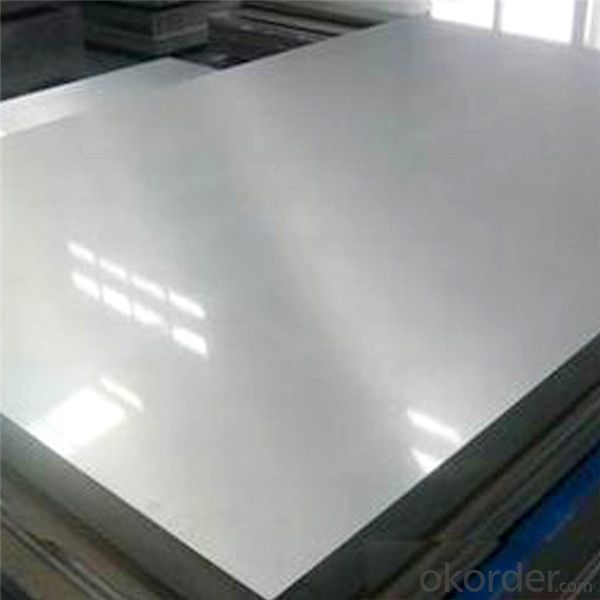
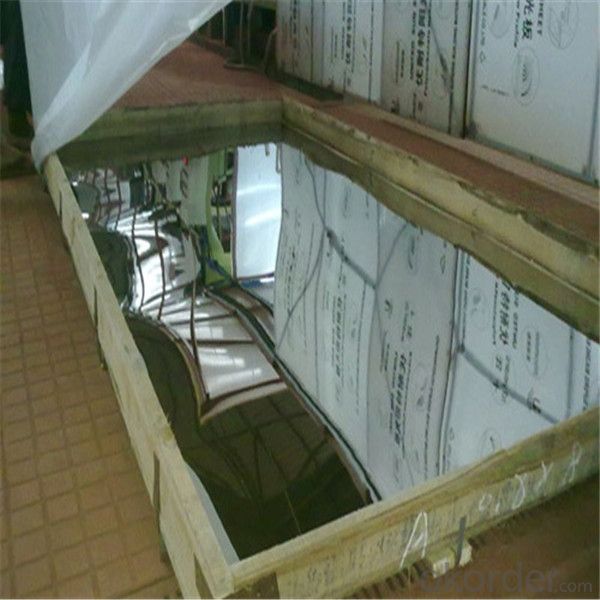
- Q:How do you determine the best grade of stainless steel sheet for a specific application?
- Determining the best grade of stainless steel sheet for a specific application involves considering several factors. Firstly, it is important to assess the environmental conditions the sheet will be exposed to, such as temperature, humidity, and potential exposure to corrosive substances. This will help determine the required corrosion resistance of the stainless steel. Secondly, the mechanical properties required for the application should be considered. This includes factors like strength, hardness, and ductility. The intended use of the stainless steel sheet, whether it is for structural purposes or for a decorative application, will help determine the necessary mechanical properties. Additionally, the fabrication process and any subsequent treatments or finishes should be taken into account. Some grades of stainless steel may be more suitable for forming, welding, or machining, depending on their composition and characteristics. Furthermore, it is important to consider the cost implications of different stainless steel grades. Higher grades often come with a higher price tag, so it is crucial to balance the required performance with the available budget. To determine the best grade of stainless steel sheet, it is advisable to consult with experts in the field, such as stainless steel suppliers or engineers with expertise in materials selection. They can provide guidance based on their knowledge and experience, taking into consideration the specific requirements of the application.
- Q:How are stainless steel sheets made?
- Stainless steel sheets undergo a process called hot rolling to be produced. This starts by melting iron, nickel, chromium, and other elements in an electric arc furnace. The resulting mixture is then cast into large rectangular blocks known as slabs. The slabs are subjected to high temperatures and passed through a series of hot rolling mills. These mills consist of large rollers that gradually decrease the slab's thickness while increasing its length and width. As the slab goes through each rolling mill, it is constantly squeezed by the rollers, resulting in a thinner and longer sheet. Following the hot rolling process, the stainless steel sheet goes through annealing. This involves heating the sheet to a specific temperature and then allowing it to cool slowly. This process helps release internal stresses and enhance the material's mechanical properties. Next comes pickling, where the sheet is submerged in an acid solution to eliminate any surface impurities and oxides. This improves the appearance and corrosion resistance of the stainless steel. Once the pickling process is done, the sheet undergoes cold rolling. Cold rolling further decreases the sheet's thickness and improves its surface finish. This is done at room temperature, increasing the hardness and strength of the stainless steel. Lastly, the stainless steel sheet undergoes various finishing processes. These may include cutting to size, leveling, surface polishing, and coating to enhance appearance or protect against corrosion. In conclusion, the manufacturing process of stainless steel sheets involves a combination of melting, casting, hot rolling, annealing, pickling, cold rolling, and finishing processes. This ensures that the final product meets the desired specifications in terms of thickness, strength, and surface finish.
- Q:What's the difference between galvanized steel and stainless steel?
- Stainless steel is often divided into martensitic steel, ferritic steel, austenitic steel, austenitic ferrite (duplex) stainless steel and precipitation hardening stainless steel according to the state of the organization. In addition, can be divided into components: chromium stainless steel, chromium nickel stainless steel and chromium, manganese, nitrogen, stainless steel and so on.
- Q:What are the different types of stainless steel sheet surface textures available?
- Stainless steel sheets come in a variety of surface textures, each with its own unique visual and functional properties. Here are some of the most commonly used surface finishes: 1. No.1 Finish: This is the most widely used surface finish for stainless steel sheets. It is achieved by hot rolling the steel and then annealing it, resulting in a smooth and reflective surface. 2. No.2B Finish: Compared to No.1 finish, this finish has a slightly rougher texture. It is achieved by cold rolling the steel and then annealing it, giving it a dull and matte appearance. 3. No.4 Finish: Also known as satin or brushed finish, this surface texture has a fine grain appearance with short, parallel lines. It is achieved by polishing the surface with abrasive belts or brushes. 4. Hairline Finish: Similar to No.4 finish, this surface texture has a finer grain appearance. It is achieved by polishing the surface with abrasive belts or brushes in a unidirectional pattern. 5. No.8 Mirror Finish: This is the most reflective surface texture available for stainless steel sheets. It has a highly polished and mirror-like appearance, achieved by further polishing the surface after No.4 finish. 6. Bead Blasted Finish: This surface texture is achieved by blasting the stainless steel sheet with fine glass beads or ceramic particles. It results in a textured, non-reflective surface with a uniform matte appearance. 7. Embossed Finish: This surface texture involves imprinting a pattern or design onto the stainless steel sheet. It can be achieved through mechanical embossing or by using a special roller during the manufacturing process. 8. Colored Finishes: In addition to the above surface textures, stainless steel sheets can also be coated with various colors to enhance their visual appeal. These colored finishes are achieved through processes like PVD (Physical Vapor Deposition) or powder coating, resulting in a durable and vibrant surface. These are just a few examples of the many surface textures available for stainless steel sheets. The choice of surface texture depends on the desired aesthetic, functional requirements, and specific application of the stainless steel sheet.
- Q:Are stainless steel sheets suitable for brewery equipment?
- Brewery equipment greatly benefits from the use of stainless steel sheets. This material is highly preferred in the brewing industry because of its numerous advantageous properties. Firstly, stainless steel is resistant to corrosion, making it an ideal choice for equipment that comes into contact with liquids and chemicals used throughout the brewing process. Its corrosion resistance plays a crucial role in preserving the quality and purity of the beer being brewed. Moreover, stainless steel is exceptionally easy to clean and sanitize, which is of utmost importance in maintaining hygiene standards within a brewery. Being non-porous, it does not absorb or retain odors, flavors, or bacteria, thus ensuring that the beer remains uncontaminated during production. Additionally, stainless steel boasts a smooth surface, preventing the accumulation of bacteria or other contaminants that could potentially compromise the quality of the beer. Furthermore, stainless steel exhibits remarkable durability and longevity, making it capable of withstanding the demanding conditions of a brewery environment, such as high temperatures, moisture, and constant usage. This durability guarantees that brewery equipment crafted from stainless steel sheets will have an extended lifespan, reducing the need for frequent replacement or repairs. All in all, stainless steel sheets serve as an outstanding choice for brewery equipment due to their corrosion resistance, ease of cleaning, sanitation properties, and durability. Utilizing stainless steel in brewery equipment significantly contributes to maintaining the quality and purity of the beer, thereby ensuring an enhanced end product for consumers.
- Q:Can stainless steel sheets be used for elevator cabs?
- Yes, stainless steel sheets can be used for elevator cabs. Stainless steel is a popular material choice for elevator cabs due to its durability, resistance to corrosion, and aesthetic appeal. It provides a sleek and modern look, making it a desirable option for both commercial and residential elevators. Stainless steel sheets can be easily fabricated and customized to fit the specific dimensions and design requirements of an elevator cab. Additionally, stainless steel is easy to clean and maintain, which is important for high-traffic areas like elevators. Overall, stainless steel sheets are a suitable and reliable choice for elevator cabs.
- Q:Are stainless steel sheets suitable for roofing applications?
- Yes, stainless steel sheets are suitable for roofing applications. Stainless steel is known for its durability, resistance to corrosion, and strength, making it an ideal material for roofs. It can withstand harsh weather conditions, including extreme temperatures, high winds, and heavy rainfall. Stainless steel sheets are also fire-resistant, which adds an extra layer of safety to the roof. Additionally, stainless steel has a long lifespan, requiring minimal maintenance and repairs. Overall, stainless steel sheets provide a reliable and long-lasting solution for roofing applications.
- Q:Can stainless steel sheets be used for staircase railings?
- Yes, stainless steel sheets can be used for staircase railings. Stainless steel is a durable and corrosion-resistant material, making it suitable for outdoor and indoor applications. Additionally, its sleek and modern appearance adds an aesthetic appeal to staircase railings.
- Q:Can stainless steel sheets be used for elevator frames?
- Yes, stainless steel sheets can be used for elevator frames. Stainless steel is a preferred material for elevator frames due to its strength, durability, and resistance to corrosion, making it suitable for withstanding the regular wear and tear of elevator usage.
- Q:Are stainless steel sheets resistant to chemicals?
- Yes, stainless steel sheets are generally resistant to chemicals. Due to their high levels of chromium and nickel, stainless steel sheets exhibit excellent resistance to corrosion from a wide range of chemicals, making them suitable for various industrial and commercial applications.
1. Manufacturer Overview |
|
|---|---|
| Location | |
| Year Established | |
| Annual Output Value | |
| Main Markets | |
| Company Certifications | |
2. Manufacturer Certificates |
|
|---|---|
| a) Certification Name | |
| Range | |
| Reference | |
| Validity Period | |
3. Manufacturer Capability |
|
|---|---|
| a)Trade Capacity | |
| Nearest Port | |
| Export Percentage | |
| No.of Employees in Trade Department | |
| Language Spoken: | |
| b)Factory Information | |
| Factory Size: | |
| No. of Production Lines | |
| Contract Manufacturing | |
| Product Price Range | |
Send your message to us
321 Stainless Steel Sheet perfect price strong hardness
- Loading Port:
- Shanghai
- Payment Terms:
- TT OR LC
- Min Order Qty:
- 1 m.t.
- Supply Capability:
- 20000 m.t./month
OKorder Service Pledge
OKorder Financial Service
Similar products
New products
Hot products
Hot Searches
Related keywords
